
|  |  |  Vallarta Living | October 2008 Vallarta Living | October 2008  
Tales of 'Prepa' - Vallarta's College Preparatory High School
 Polly G. Vicars - PVNN Polly G. Vicars - PVNN

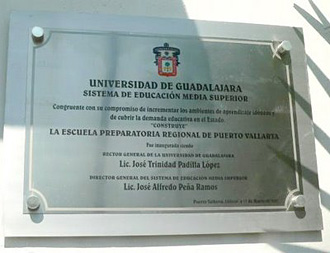
| The official plaque at the entrance to what we locals call "Prepa".
La placa oficial de lo que nosotros llamamos "Prepa". | 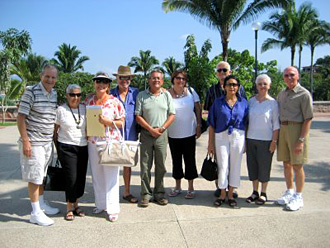
| Our group: Husband AKA Hubert Vicars, me, President Becas Vallarta Mariel Fregoso, President AMF Carlos Fregoso, Director Dr. Armando Soltero Macías, Linda Azcarate, Cecile Scriban, Rod Scriban, Sylvia Sorenson, Vern Sorenson
Nuestro grupo: Mi esposo AKA Hubert Vicars, yo, la Presidenta de Becas Vallarta Mariel Fregoso, Presidente AMF Carlos Fregoso, Director Dr. Armando Soltero Macías, Linda Azcarate, Cecile Scriban, Rod Scriban, Sylvia Sorenson, Vern Sorenson | 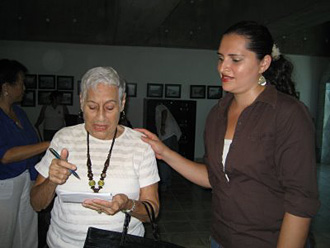
| Ada Minerva Ulloa Pelayo, Secretary at the Prepa and a huge help to me and to the Becados helping me keep all the names straight.
Ada Minerva Ulloa Pelayo, Secretaria de la Prepa una gran ayuda para mí y los becados para poner sus nombres correctamente. | 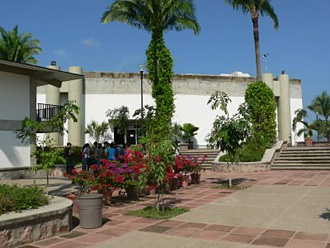
| Beautiful Campos brightly decorated with local flora.
Hermosos campos decorados brillantemente con la flora local. | 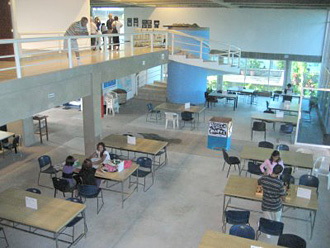
| Space to study, work and socialize below the offices and library.
Área para estudiar, trabajar y socializar en la parte baja de las oficinas y biblioteca. | 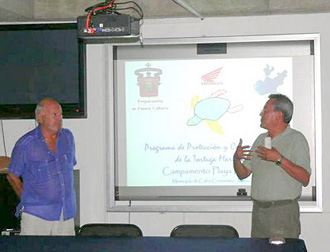
| Carlos Fregoso and Dr. Soltero explaining the extracurricular programs.
Carlos Fregoso con el Dr. Soltero quien explica los programas extracurriculares. | 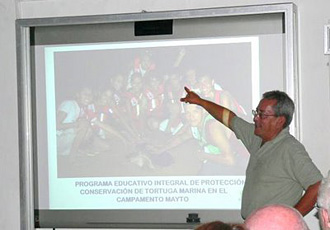
| Dr. Soltero proudly showing some of his students learning about the turtles at Mayto Beach.
Dr. Soltero muy orgulloso muestra algunos de sus estudiantes aprendiendo sobre Tortugas Marinas en la Playa de Mayto. | 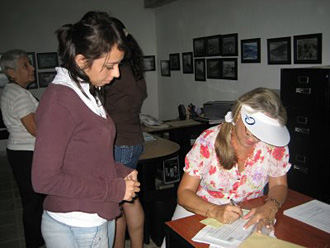
| New Becada Tanya getting her Scholarship from President Mariel Fregosa.
Nueva Becada Tania recibiendo su beca de la Presidenta Mariel Fregoso. | 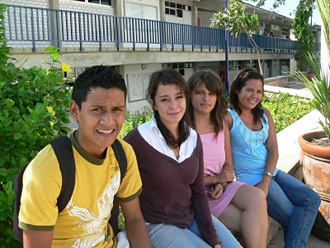
| Becados at Prepa, David Dueñas López, Tania del Rocio Arreguin Rivera, Astrid Giovanna Arellano Castro and Ana Karen Delgado Gutiérrez.
Becados en la Prepa, David Dueñas López, Tania del Roció Arreguin Rivera, Astrid Giovanna Arellano Castro, y Ana Karen Delgado Gutiérrez. | | |
Some say there are no coincidences, but my experiences this week belie their statements. On Monday Mariel and Carlos Fregoso, presidents of Becas Vallarta, A.C. and the America-Mexico Foundation, Inc. respectively, with a group of members of the scholarship foundations, journeyed to El Pitillal to see a newly built high school, referred to by locals as "Prepa." This is a college preparatory high school run by the University of Guadalajara that has recently moved onto a brand new campus.

Then on Tuesday, Husband and I, while walking to our Pilates classes (look for an account of our adventures there very soon) picked up the current edition of the local daily newspaper, "Vallarta Today." We arrived early for our classes, so I perused the paper. Three articles particularly interested me: the Olive-Ridley Turtle Protection Program; Reforestation in Mexico; and another on local kids with cancer.

In a few minutes of chit chat with Ron when he was through with his class and I hadn't started mine, I mentioned our visit to Prepa. Ron responded with something like, "isn't it awful how bad the schools are here."

Having worked with the local schools through Becas Vallarta for almost the whole twenty years we have lived here and carefully keeping up with the education in the public schools of Yesi and Alex, children of Spanish maestro and best friend Melchor Cortes, I know a thing or two about our schools. I quickly replied with some facts about how good our schools really are.

Surprised, but willing to be educated, Ron said all he knew was that the buildings looked pretty bad. I agreed that some of the buildings leave much to be desired, but explained that what goes on inside is what counts and that wonderful things are going on.

Back to the visit to Prepa where they not only have state of the art buildings with incredible programs going on inside, they have (coincidentally) one on Olive-Ridley Turtle Protection, one on Reforestation and one on helping local children who have cancer.

Our group was greeted by Dr. Armando Soltero Macías, Director of the University of Guadalajara's Prepartoria Regional de Puerto Vallarta. This charming and dynamic man quickly put us all at ease and gave us a quick overview of the school and how it works. He gave us these statistics: 1600 students in this Prepa, 1500 in the three other branches located in the villages of Tómatlan, El Tuito and Ixtapa.

Then, inside the main building that houses the spacious library and meeting rooms we met some of the staff, including Ada Minerva Ulloa Pelayo, secretary of the school for many years. She and I had talked on the telephone many times, so it was a pleasure to meet her in person and thank her for all she does for the students and the school.

Dr. Soltero explained that his annual budget of one million USD per year contrasts with a comparable school in Illinois whose budget is $55 million. But what he does with that one million is almost miraculous.

In addition to the fine regular college preparatory courses which are rigorous and top notch, the extra curricular programs are outstanding! For example they have the only high school Turtle Protection project in the world. They have many sponsors for this program to help defray the costs, the largest of which is Honda Mexico.

The turtle project is centered in the small village of Mayto Beach, a little known locale two hours south of Vallarta. You pass through the little pueblo of El Tuito, then take the primitive dirt road to the secluded and beautiful beach that is home to the Turtle Program and not much more. A permanent camp is located on this beach with tents for sleeping, cooking, eating and recreating. Power is provided by solar panels and wind turbines. There is a crew of scientists augmented by volunteers from Prepa.

The season for the turtles to lay their eggs runs from July to November. The turtles are under threat from the time the eggs are laid. In the nest they are subject to poaching by wild and domesticated animals as well as humans for whom the fertilized eggs are a delicacy to eat and profitable to sell. Thus the removal of the eggs to a safely guarded area at least guarantees they will hatch.

The tiny hatchling turtles are about one and one half inches long and weigh less than one ounce. So if they are allowed to hatch in the unprotected wild, their sojourn from the beach to the water in broad daylight would be subject not only to dogs and wild animals, but to the many sea birds that search for food along the shores and shallow waters.

Every night the beach is patrolled looking for newly made nests, some of which might hold up to 100 eggs. The volunteers carefully dig up the buried eggs and transport them to the camp to be re-buried in guarded, temperature controlled nests.

It has been discovered that the sex of the turtle is not pre-determined, but by the incubation temperature; high temperature produces females, low produces males. Different levels of the nests have different temperatures thus each nest produces both sexes. The staff watches over the sand nests carefully, altering the temperature by using tarpaulins to increase or decrease the heat inside

When the tiny turtles hatch they are rinsed and then held until nightfall where they are released in the sand to allow them to crawl into the sea. It is thought that when they crawl across the sand they get an imprint of the magnetic features of that location, thus allowing them to return to the same spot many years later to lay their eggs. What an incredible chain of events! Some say they can pinpoint with 100 yards the actual spot where they went into the sea.

Now, enough about the turtles and time to talk about the Prepa kids. About 40 (all volunteers) go out on the weekends to spend 3 days and 2 nights working with the turtles. They patrol the beaches, dig up eggs, plant them again, take care of the hatchlings and help in the release.

As Dr. Soltero said, one weekend with the project is more powerful than a whole year of classroom animal biology. You can be assured that these students will be leaders in turtle protection in the future.

Dr. Soltero also talked to us about their vibrant reforestation program where the students grow up to thirty-six thousand hard wood native trees each year to give to surrounding communities, including our own Vallarta. These students plant the seeds, nurture the seedlings, transplant the trees to needed areas. In the "Vallarta Today" article I had read, Ron Walker quoted the National Forestry and Soil Inventory 2004-2009 as showing an increase of forest area of 56.8 million hectares or 13%. I am sure the work of Prepa's students has helped make this increase.

The other coincidental article was about Vallarta Adventures giving local children with cancer a day at the Dolphin Center. Dr. Soltero told us of Prepa's ongoing program to work with children with cancer as well as those with severe burns. The students interact with the afflicted children while learning compassion and sharing skills for themselves. They work to arrange for the burn victims to go to the Shriner's Hospital in Galveston, Texas. What marvelous experiences for these young students as well as for those whom they are helping.

These are merely three of the extracurricular programs at Prepa. There are many others including a remarkable one that discourages teenage pregnancies.

Before leaving Prepa we had a short visit with four of our scholarship students: Astrid Giovanna Arellano Castro, Ana Karen Delgado Gutiérrez, Tania del Rocio Arreguin Rivera and David Dueñas López. Tania actually received her scholarship from President Mariel on this visit. She is a welcome addition to our group with her grade point average of 9.5 out of 10.

It was such a pleasure to visit with these bright and ambitious young people. We all left Prepa with great pride in our becados, the school and its superior faculty and staff. In these perilous times it gave a burst of optimism that one day all will be right again.
 Polly G. Vicars and her husband of 57 years, Hubert (a.k.a. "Husband") retired to Puerto Vallarta in 1988 and soon became active members of several charitable organizations. Polly is the author of "Tales of Retirement in Paradise: Life in Puerto Vallarta, Mexico" [a sell-out!] and "More Tales of Retirement in Puerto Vallarta and Around the World." Proceeds from the sale of her books go to the America-Mexico Foundation, a scholarship foundation that is their passion. Polly G. Vicars and her husband of 57 years, Hubert (a.k.a. "Husband") retired to Puerto Vallarta in 1988 and soon became active members of several charitable organizations. Polly is the author of "Tales of Retirement in Paradise: Life in Puerto Vallarta, Mexico" [a sell-out!] and "More Tales of Retirement in Puerto Vallarta and Around the World." Proceeds from the sale of her books go to the America-Mexico Foundation, a scholarship foundation that is their passion.

Click HERE for more articles by Polly Vicars, or click HERE to learn more about Becas Vallarta and the America-Mexico Foundation.
Anécdotas de la "Prepa" de Vallarta
Por Polly G. Vicars y Traducidos por Maripepa González

Algunas personas dicen que no hay coincidencias, pero mi experiencia de esta semana, me hace no estar totalmente de acuerdo. El Lunes Mariel y Carlos Fregoso, Presidentes de Becas Vallarta, A.C. y la Fundación America-Mexico, Inc. respectivamente, con un grupo de los fundadores de las becas, fuimos al Pitillal a ver la nueva escuela Preparatoria, llamada por los locales la "Prepa." Esta es una escuela que prepara para el siguiente paso, es parte de la Universidad de Guadalajara, y está estrenando instalaciones.

Después, el Martes, mi esposo y yo, en camino hacia nuestra clase de Pilates (busquen sobre nuestras aventuras de esto muy pronto) recogimos la edición del periódico local, "Vallarta Today." Llegamos temprano a nuestras clases, así que me puse a leer el periódico. Tres artículos me interesaron particularmente…: Uno sobre el Programa de Protección a la Tortuga marina: Reforestación en México; y el tercero de niños locales con cáncer.

En unos pocos minutos de plática con Ron cuando el había terminado su clase, y yo aún no iniciaba la mía, mencioné nuestra visita a la Prepa. Ron respondió con un comentario parecido a "¿No es horrible lo mal que están las escuelas aquí? Habiendo trabajado con escuelas locales a través de Becas Vallarta por 20 años que hemos vivido aquí, dando cuidadoso seguimiento a la educación en escuelas públicas de Yesi y Alex, hijos de Melchor Cortés, maestro de Español y nuestro buen amigo, yo digo que conozco bastante de una o dos escuelas. Yo le respondí rápidamente con hechos sobre lo buenas que son nuestras escuelas. Sorprendido, pero deseando aprender, Ron me dijo que lo único que sabía era que los edificios se veían muy mal. Yo estuve de acuerdo que muchas construcciones dejaban mucho que desear, pero le expliqué que lo que sucede adentro es lo que cuenta, y que hay cosas maravillosas sucediendo dentro de ellas.

Regresando a nuestra visita a la Prepa donde no solo son modernas instalaciones, sino increíbles programas educativos dentro, y tienen (coincidencia) uno sobre Protección a la Tortuga Golfín, otro sobre Reforestación y finalmente uno para apoyar a niños vallartenses que tienen cáncer. A nuestro grupo le dio la bienvenida el Director de la Preparatoria Regional de la Universidad de Guadalajara, el Dr. Armando Soltero Macías. Este hombre encantador y dinámico, rápidamente nos hizo sentir en casa, y nos explico cómo funciona la escuela. Nos dio estas estadísticas, tiene 1,600 estudiantes en la Prepa. 1,500 en las otras 3 ramas localizadas en las poblaciones de Tomatlán, El Tuito e Ixtapa.

Posteriormente, dentro del edificio principal que alberga una espaciosa librería y salones de reuniones, conocimos a algunas personas del personal incluyendo a Ada Minerva Ulloa Pelayo, secretaria de la escuela por muchos años. Habíamos hablado varias veces por teléfono, así que fue un placer conocerla en persona y agradecerle todo lo que hace por los estudiantes y por la escuela.

El Dr. Soltero explicó que su presupuesto anual de un millón de dólares contrasta con el de una escuela comparable en Illinois que supera los 55 millones de dólares. Pero él hace milagros con ese millón. ¡Además de los cursos regulares en la Preparatoria que son rigurosos y de excelente nivel, los programas extra curriculares son increíbles! Por ejemplo tienen el único programa en el mundo de una Preparatoria para protección a la tortuga Marina. Tienen patrocinadores que les ayudan a sustentarlo y pagar sus costos, el más importante de ellos es Honda México.

El proyecto de las Tortugas, se encuentra centralizado en la playa de Mayto una pequeña población localizada a dos horas al sur de Vallarta. Se tiene que pasar por el pueblo del Tuito, tomar una carretera sin pavimentar a la primitiva y hermosa playa hogar del Programa de protección a la Tortuga Marina y no mucho más. Un campamento permanente localizado en esta playa, con tiendas de campaña para dormir, cocinar, comer y divertirse. La electricidad se obtiene de páneles solares y turbinas de aire. Hay un equipo de científicos, que son apoyados por voluntarios de la Prepa.

La temporada de anidación de tortugas marinas es de julio a noviembre. Las tortugas están amenazadas desde el momento en que los huevos son puestos por la madre. En el nido, pueden ser atacados por animales salvajes o domesticados y también como por el ser humano para quien los huevos son considerados una delicatesen, y deja ganancias venderlos. Por ello el remover los nidos a un lugar resguardado, al menos garantiza un mayor número de nacimientos. Las tortuguitas recién nacidas, miden como una pulgada y media de largo, pesan menos de una onza. Así que dejarlas desprotegidas en la naturaleza, su viaje desde la playa al agua, durante el día, no solo se verá amenazado por perros y animales salvajes, sino que serán alimento de muchas de las aves que buscan buena comida a la orilla del mar y en aguas poco profundas.

Cada noche la playa es patrullada para buscar nuevos nidos, algunos de los cuales tienen más de 100 huevos. Los voluntarios excavan cuidadosamente en el nido para sacar los huevos y volver a enterrarlos en el lugar resguardado y con temperaturas controladas. Se ha descubierto que el sexo de la tortuga no está predeterminado, pero se define por la temperatura de la incubación, temperaturas más altas producen hembras, temperaturas bajas producen machos. Los diferentes niveles de los nidos, producen variadas temperaturas, por lo tanto de un nido nacerán ambos sexos. El personal está muy pendiente de los nidos en la arena, alterando la temperatura si es necesario utilizando tarpaulins para incrementar o disminuir el calor dentro del mismo.

Cuando las tortuguitas nacen, son puestas en agua y se espera hasta que anochece para liberarlas y permitirles que vayan hacia el mar. Se piensa que durante su camino por la arena, marcan el lugar, y regresarán al mismo lugar unos años más tarde a poner sus huevos. ¡Que increíble cadena de eventos! Algunos dicen que pueden llegar tan cercanos a 100 metros del punto donde iniciaron su carrera en el mar.

Ahora, suficiente de las tortugas, y es tiempo de hablar de los chicos de la Prepa. Cerca de 40 (todos voluntarios) van a trabajar los fines de semana 3 días y 2 noches con las tortugas. Ellos patrullan las playas, sacan los huevos, los vuelven a enterrar, cuidan durante las liberaciones. Como nos mencionó el Dr. Soltero un fin de semana en el proyecto, es más poderoso que un año entero en el salón de clases estudiando biología animal. Pueden estar seguros que esos estudiantes serán lideres en la protección a la tortuga en un futuro.

El Dr. Soltero también nos habló sobre su programa de reforestación donde los estudiantes producen más de treinta y seis mil árboles de maderas preciosas y árboles de la región que siembran en los alrededores de las comunidades, incluyendo el propio Vallarta. Estos estudiantes siembran las semillas, cuidan las plantaciones, y trasplantan los arboles a las aéreas necesitadas. En el artículo que había leído en "Vallarta Today", Ron Walker mencionó que el inventario de la reforestación Nacional de 2004-2009 mostraba un incremento del área forestal de 56.8 millón de hectáreas o 13%. Estoy segura que los estudiantes de la Prepa ayudaron en estos resultados.

La otra coincidencia del tercer artículo era sobre Vallarta Adventures apoyando a los niños con cáncer con un día en el Delfinario. El Dr. Soltero nos comentó que la Prepa tiene además del programa de ayuda a niños con cáncer, otro que ayuda a niños con severas quemaduras en la piel. Los estudiantes interactúan con esos niños aprendiendo compasión y metas para ellos mismos. Trabajan para facilitar a las víctimas para que acudan al Hospital Shriner's en Galveston, Texas. Que maravillosas experiencias tanto para los estudiantes como para aquéllos que reciben ayuda.

Estos son muy escuetos tres de los programas extracurriculares de la Prepa. Hay muchos más incluyendo uno donde se orienta a los adolescentes para evitar embarazos prematuros o no deseados.

Antes de dejar la Prepa tuvimos una corta visita a cuatro de nuestros becados: Astrid Giovanna Arellano Castro, Ana Karen Delgado Gutiérrez, Tania del Roció Arreguín Rivera y David Dueñas López. Tania recibió su beca de la Presidente Mariel durante su visita. Ella es muy bienvenida, con su promedio de calificaciones de 9.5 sobre 10. Fue un placer nuestra visita a estos brillantes jóvenes llenos de ambiciones. Todos salimos muy orgullosos de la Prepa, de nuestros becados, de la escuela, de sus programas y de su equipo. En estos tiempos difíciles, nos dieron un aire de optimismo, y la esperanza de que algún día todo volverá a estar bien nuevamente. |

 |
|  |



